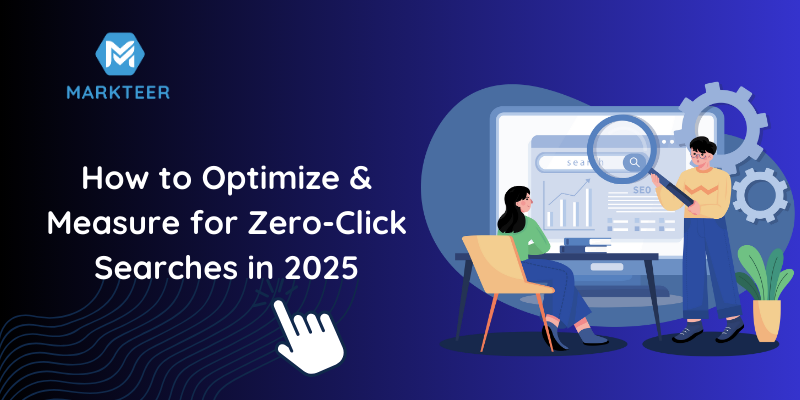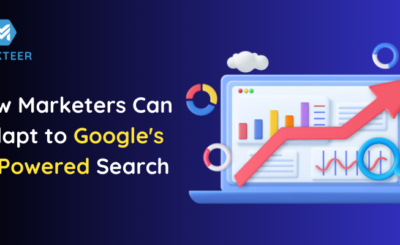In 2025, more than ever, Google’s search engine delivers answers before users click. Known as zero-click searches, these queries end without the user visiting any website. This shift is primarily driven by features like featured snippets, knowledge panels, and People Also Ask (PAA) boxes, offering users immediate answers on the search engine results page (SERP).
According to SparkToro, as far back as 2020, over 64% of Google searches ended without a click. This figure has only grown, with SimilarWeb reporting that zero-click rates now exceed in some niches. A European Commission’s Joint Research Centre study further highlighted how Google’s increasing ability to provide direct answers within the SERP impacts user click behavior across Europe.
To stay visible, brands must optimize not just for rankings but also for SERP features that drive impressions and authority even without clicks.
Understanding Search Behavior & Intent in a Zero-Click World
Today’s users are increasingly task-focused. With mobile and voice searches becoming dominant, people expect quick, concise answers—especially for navigational and informational intents. Instead of sifting through multiple websites, they prefer Google’s built-in answers.
Google’s tools reinforce this behavior. Features like the Knowledge Graph, Instant Answers, and Featured Snippets are designed to satisfy user queries instantly. Research from WordStream reveals that zero-click queries are widespread in areas like weather, definitions, unit conversions, and local results, where a full visit to a site isn’t needed.
Moreover, the rise in voice search, used by over 50% of internet users globally, according to Statista, has contributed to the increase in short-form query resolutions, often ending in zero clicks.
In short, digital marketing strategies in 2025 must focus on visibility within the SERP, not just click-through rate (CTR).
Also Read: The Impact of AI-Generated Content on SEO Rankings
Top 5 Strategies to Optimize for Zero-Click Searches
1. Target Featured Snippets with Precision
Featured snippets—those boxed answers at the top of SERPs—are the prime real estate for zero-click exposure. To win these:
- Format content to answer questions directly.
- Use headings with query-based phrasing (e.g., “What is zero-click search?”).
- Keep answers
According to SEMrush, pages that land featured snippets usually use clear headers, bullet points, and numbered lists, dominating desktop and mobile visibility. As per Search Engine Land, these formats are preferred because they match Google’s NLP algorithms that extract quick answers.
2. Leverage Schema Markup for Rich Snippets
Adding structured data to your site helps Google understand your content. For example:
- FAQ Schema can earn collapsible questions directly in the SERPs.
- How-to schema is ideal for step-by-step tutorials.
- Local Business Schema enhances location-based searches.
Using schema increases the chance of being pulled into rich results, which stand out visually and are often the centerpiece of zero-click queries. Google’s own developer’s guide emphasizes how schema improves content discoverability.
According to data compiled by Schema.org, websites using structured data see a 12–30% higher click-through rate even when featured in zero-click formats.
3. Optimize for Local SEO via Google Business Profile
For businesses with a physical footprint, showing up in the Google Local Pack can drive massive exposure, even without a website visit.
To optimize:
- Claim and fully update your Google Business Profile.
- Add relevant categories, high-quality images, business hours, and FAQs.
- Respond to reviews and use keywords naturally in your responses.
A Moz report finds that local pack visibility is most influenced by profile completeness, reviews, and NAP consistency—critical elements in earning zero-click traffic for location-based queries.
4. Build FAQ Sections That Answer Questions Instantly
Many users type long-form questions into search engines, especially with voice search. Creating dedicated FAQ sections directly addresses these needs.
- Use data from tools like AnswerThePublic or People Also Ask queries.
- Answer in short, to-the-point formats.
- Apply the FAQ Schema to increase the chances of your content being pulled into Google’s FAQ snippet blocks.
Incorporating this strategy has helped businesses increase impressions by over 30%, as shown in a case study published in Search Engine Journal.
5. Keep It Simple: Craft Clear, Direct Answers
Google prefers well-structured, concise content. Use:
- Short paragraphs.
- Active voice.
- Logical hierarchy of H2s and H3s.
This format helps Google extract information for snippet inclusion. A Backlinko study of 1 million search results found that snippet answers most often came from content near the top of a page, under a header, and in short, well-formatted text.
How to Measure Success in Zero-Click SEO
Since zero-click searches don’t always result in direct traffic, measuring success requires a different approach.
1. Use Google Search Console for Impressions
In Google Search Console, focus on:
- Impressions (how often your page is shown in search).
- Average Position (indicates SERP ranking).
- Coverage Reports (to ensure your schema and rich snippets are indexed correctly).
High impressions with low clicks may still be a winning strategy if your brand is consistently seen in high-value searches.
2. Track Brand and Engagement Metrics
Zero-click doesn’t mean zero value. Users who see your snippet may later:
- Visit directly.
- Search for your brand.
- Engage via social media.
Use Google Analytics and tools like Hotjar or Microsoft Clarity to monitor:
- Direct traffic spikes.
- Time on page and bounce rate from branded queries.
- Referral traffic from snippets or third-party syndications.
3. Use Third-Party SEO Platforms
SEO tools like Ahrefs, SEMrush, and Similarweb offer zero-click visibility metrics. For example:
- Featured Snippet tracking.
- SERP feature presence per keyword.
- Click potential estimation helps gauge if a keyword is likely to be zero-click.
These insights help refine content strategies and prioritize queries based on visibility potential—not just traffic.
The Real Impact of Zero-Click Searches on Organic Traffic
Some may fear zero-click searches will kill SEO, but that’s not the whole picture.
Traffic may indeed dip, especially for transactional or navigational queries. However, visibility in SERP features still builds:
- Brand authority
- Voice search compatibility
- Customer trust
According to Briskon, industries like health, education, and weather saw a 15–25% decline in organic clicks due to zero-click content. However, companies that adapted their SEO to include structured content, schema, and direct answers saw brand impressions rise by over 40%.
Further validation comes from a European Parliament study highlighting how zero-click outcomes benefit established brands by reinforcing visibility and trust, even in competitive markets.
Best Practices for Long-Term Adaptation
To sustain visibility:
- Update content regularly to retain featured snippet positions.
- Use ChatGPT or Surfer SEO tools to discover content gaps or snippet opportunities.
- Diversify traffic sources—combine zero-click SEO with social, email, and PPC campaigns.
- Monitor SERP changes as Google continually evolves its interface, especially with AI-driven overviews rolling out.
Conclusion: Embrace the Visibility Game
Zero-click searches may limit traditional traffic but open doors to higher visibility, greater authority, and brand recall—the SEO landscape in 2025 demands adaptability. Rather than chasing every click, savvy marketers will optimize for answers, structure, and trust signals.
By embracing this new dynamic, your brand doesn’t just survive—it thrives.






